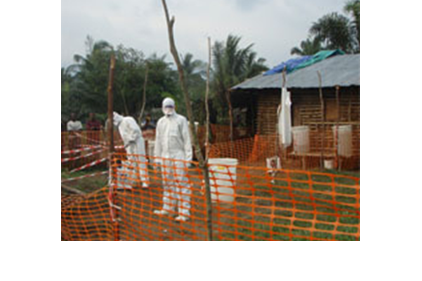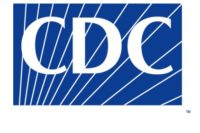The Ebola containment strategy in Lofa County had several key elements:
- Encouraging community behavior change, including safe burial practices.
- Establishing an ETU
- Setting up a local Ebola hotline and outreach teams that quickly transported people with Ebola symptoms to the ETU
- Initiating active case finding, which means rigorously identifying and following up with contacts of patients with Ebola
- Training community volunteers to monitor patient contacts for Ebola symptoms
The strategy recently implemented in Lofa County might serve as a model for reducing transmission of Ebola, but the report warns that new Ebola cases continue to be reported in Lofa County, and continued vigilance is needed there and in other affected areas, including Guinea and Sierra Leone.
Ebola among Health Care Workers Not Working in Ebola Treatment Units– Liberia
A separate MMWR article released today explores how health care workers in West Africa were at increased risk of Ebola infection if they were not working in ETUs. This report, which covers events before mid-August, highlights the importance of recent key efforts of the international Ebola response in West Africa, such as establishing more ETUs and strengthening infection control in all healthcare facilities.
Isolating infected patients is essential for preventing transmission. Historically, this has been accomplished by caring for infected persons in specialized ETUs with strict isolation and infection control protocols, including guidelines for patient movement, physical layout, disinfection, and use of personal protective equipment (PPE) designed to protect health care workers and patients.
Disease detectives
CDC disease detectives and Liberia’s Ministry of Health investigated 62 Ebola cases before mid-August 2014 among health care workers not working in ETUs. The cases fell into 10 clusters, seven of which were primarily associated with hospitals.
“Health care workers in West Africa are on the front lines of the fight against Ebola. Protecting these workers will help stop the Ebola epidemic in West Africa at it source,” says CDC Director Tom Frieden, M.D., M.P.H. “Recent investments in infection control training and equipment in West Africa can reduce risk, protect workers and patients, help stop Ebola at the source, and reduce risks of spread of Ebola globally.”
Patient initially tested negative
The investigation found that in four of the 10 clusters, health care workers contracted Ebola from patients who had been admitted to a hospital and were suspected to have Ebola but did not yet have a confirmed diagnosis. In another four clusters, health care workers contracted Ebola from patients who were initially thought to have another diagnosis but eventually tested positive for Ebola. In one cluster, health care workers contracted Ebola from a patient who initially tested negative for Ebola but was tested later and came back positive.
During past Ebola outbreaks, up to 25 percent of cases have been among health care workers.
Factors in health-care-worker infections in Liberia included:
- inconsistent recognition/triage of Ebola patients;
- overcrowding of hospitals/clinics;
- limitations in physical layout of hospitals;
- lack of training in PPE and inadequate supply of PPE; and,
- limited supervision of and adherence to infection control.
Grief, fear and mistrust
The report notes that the immediate consequences of Ebola among health care workers in West Africa are closure of health facilities, loss of routine services, grief and fear among healthcare workers, and public mistrust of healthcare workers and health facilities. All undermine the overall Ebola response effort.
Since August 2014, the U.S. government and a consortium of partners have worked with the Liberian Ministry of Health to strengthen the infection control infrastructure and training in non-ETU health facilities. Infection control specialists will be embedded in non-ETU facilities.
In addition, U.S. Public Health Service medical staff have opened the Monrovia Medical Unit which is a 25-bed facility dedicated to treating medical care workers in Liberia who contract the Ebola virus.
First Ebola Virus Disease Cluster in the United States—Dallas County, Texas, 2014
In late September 2014, a patient at a Dallas hospital showed symptoms of Ebola and later tested positive for the disease. This was followed by the first two domestically acquired Ebola cases in the United States as two of the nurses caring for the patient became infected.
The patient died on October 8. Initial contact tracing identified a total of 103 individuals, of whom 48 were close unprotected contacts of the initial patient. All 48 contacts underwent direct active monitoring, which means that public health authorities contacted them directly to check on the presence of symptoms. After the two nurses became infected, health officials identified three additional Dallas community contacts; all three lived within the households of the two nurses. One hundred forty-seven health care workers who cared for the initial patient or the two nurses, irrespective of PPE use, were actively monitored. As of November 7, all contacts of the three patients had finished active monitoring and none of the contacts besides the two nurses themselves had developed Ebola.
Response to Importation of a Case of Ebola Virus Disease – Ohio, October 2014
In October, two of the nurses who treated a Dallas patient with Ebola disease became infected with the virus. Before learning that either she or her colleague were infected, one of the nurses traveled to Cleveland, Ohio and returned to Dallas via a commercial airline.
During her time in Ohio, the nurse had contact with 164 people including: two household members, 10 friends and family members, and 60 persons at one store; seventeen airline and airport personnel and 76 airline passengers were also monitored in Ohio because of contact with the nurse (other passengers were followed by health departments in other states). Some contacts were brief, while others lasted several hours and included direct skin-to-skin exposure. All of these contacts completed daily monitoring for fever or Ebola symptoms. As of November 3, the end of the incubation period and final day of monitoring, none of the contacts had developed Ebola infection.


